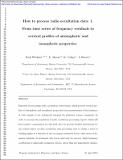How to process radio occultation data: 1. From time series of frequency residuals to vertical profiles of atmospheric and ionospheric properties
Author(s)
Withers, Paul; Moore, L.; Cahoy, Kerri; Beerer, Ingrid Mary
DownloadPages from PSS2567R1 (3).pdf (1.015Mb)
PUBLISHER_CC
Publisher with Creative Commons License
Creative Commons Attribution
Terms of use
Metadata
Show full item recordAbstract
Expertise in processing radio occultation observations, which provide vertical profiles of atmospheric and ionospheric properties from measurements of the frequency of radio signals, is not widespread amongst the planetary science community. In order to increase the population of radio occultation processing experts, which will have positive consequences for this field, here we provide detailed instructions for one critical aspect of radio occultation data processing: how to obtain a series of bending angles as a function of the ray impact parameter from a time series of frequency residuals. As developed, this tool is valid only for one-way, single frequency occultations at spherically symmetric objects, and is thus not immediately applicable to either two-way occultations, such as those of Mars Express, or occultations at oblate objects, such as Jupiter or Saturn. This tool is demonstrated successfully on frequency residuals from a Mars Global Surveyor occultation at Mars, and the resultant set of bending angles and impact parameters are used to obtain vertical profiles of ionospheric electron density, neutral atmospheric number density, mass density, pressure, and temperature via the usual Abel transform. The root-mean-square difference between electron densities in the ionospheric profile derived herein and archived electron densities is 7×10[superscript 8] m[superscript −3]. At the lowest altitudes, temperatures in the neutral atmospheric profile derived herein differ from archived neutral temperatures by less than 0.1 K. Software programs that implement these procedures accompany this paper and may be used to extract scientifically useful data products from lower-level data sets.
Date issued
2014-10Department
Massachusetts Institute of Technology. Department of Aeronautics and AstronauticsJournal
Planetary and Space Science
Publisher
Elsevier
Citation
Withers, Paul et al. “How to Process Radio Occultation Data: 1. From Time Series of Frequency Residuals to Vertical Profiles of Atmospheric and Ionospheric Properties.” Planetary and Space Science 101 (2014): 77–88.
Version: Author's final manuscript
ISSN
00320633